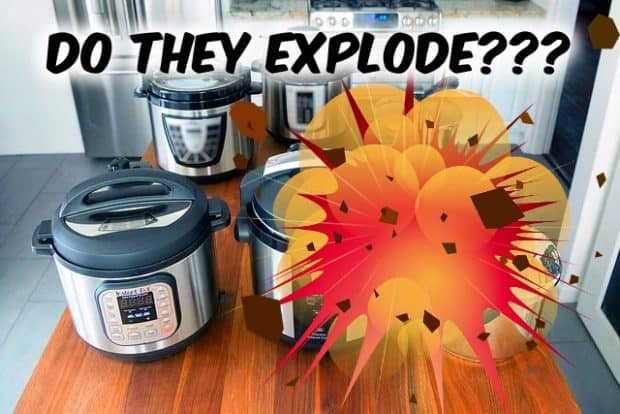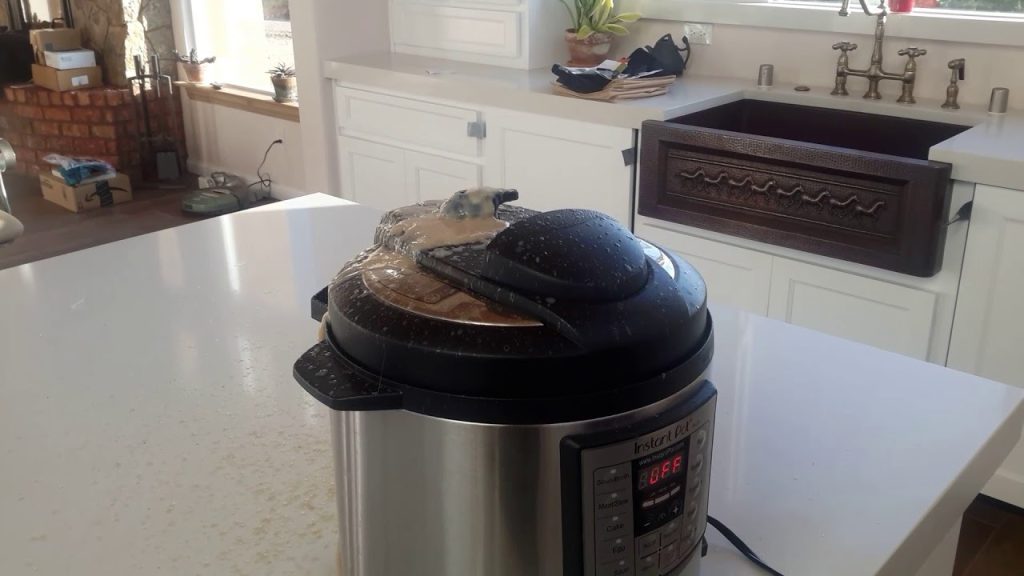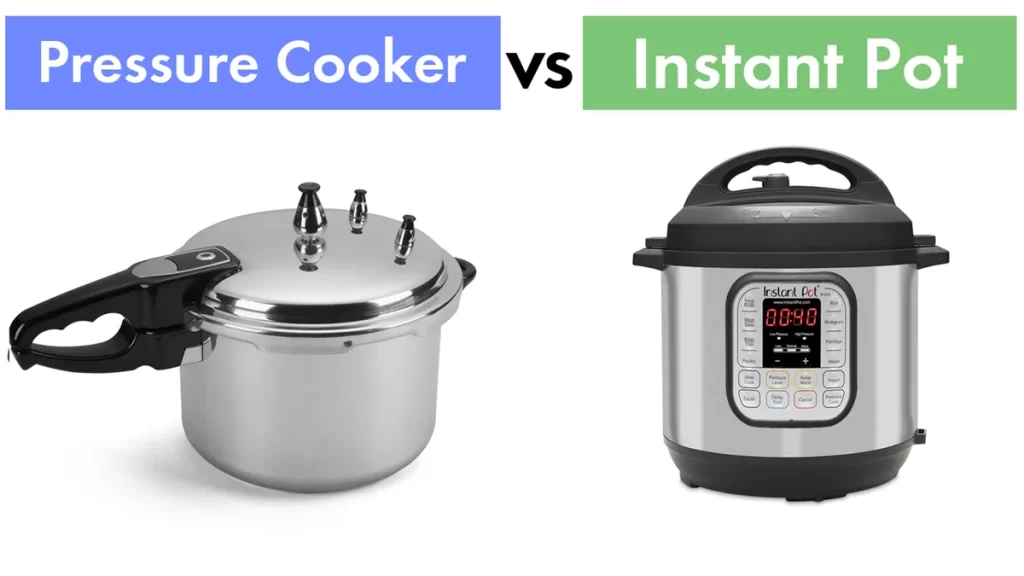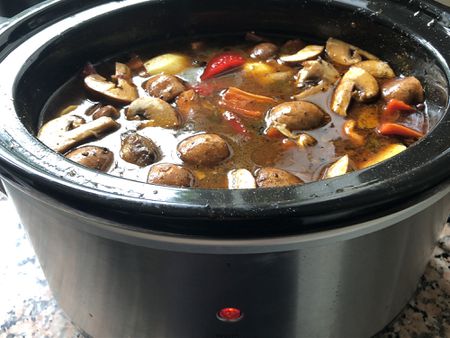Can an Instant Pot Blow Up or Explode? Everything You Need to Know!

I recently purchased an Instant Pot, believing that I would enjoy using it. However, I continued hearing about safety problems and began to worry if an Instant Pot could explode.
So I decided to explore and find out for myself. Here’s what I discovered.
If you use your Instant Pot incorrectly, it will not explode. They contain ten built-in safety safeguards that prevent them from performing dangerously. As a result, if the sensors detect a malfunction, they will instantly stop working or reduce the internal pressure.
But there’s a lot more to learn about the Instant Pot, like safety precautions and how to use it properly, so keep reading!
Is it safe to use an Instant Pot?

Instant Pots are incredibly safe, with many built-in safety safeguards to avoid misuse, injury, and cooking difficulties. However, unlike slow cookers, an Instant Pot should not be left unattended for long periods of time.
After all, an Instant Pot works by creating pressure inside the cooker, allowing your food to cook in a shorter time.
People worry about their Instant Pot exploding because of the pressure inside. However, unlike your grandmother’s 1950s pressure cooker, today’s Instant Pots have a lot of intelligent safety mechanisms built in to ensure they aren’t harmful or explode.
Let’s go over each of your Instant Pot’s ten safety features
1. Detection of Lid Closing
Your Instant Pot is a clever device. It can tell if you’ve put the lid on adequately or not. If you haven’t done so, the pressurization will not begin. With the lid removed or not on correctly, only the keep-warm and sauté buttons (in some models) work.
2. Protection against Leaky Lids
As I have stated, your Instant Pot is quite clever. Your Instant Pot won’t properly pressurize if the silicone sealing ring isn’t replaced or the steam release isn’t completely closed.
When it detects a release of steam during the pressure cooking process, it immediately switches to the Keep-warm mode since it knows that cooking while releasing pressure at the same time could result in your food being burned (because the liquid would evaporate too quickly).
3. Pressurize the lid to lock it
If you forget to release the pressure with the steam release valve first, the Instant Pot will not enable you to open the lid. There will be no explosions or lids flying in your face as a result of this.
4. Ventilation that prevents the formation of clogs
Food can get stuck on the steam release valve on the underside of the lid of your Instant Pot while it’s cooking. Fortunately, the Instant Pot has a shield that prevents you from using the release valve to release the steam when you’re ready.
5. Temperature Control via Automatic Device
The Instant Pot’s thermostat understands what temperature range to go to when you select the cooking mode, ensuring it never gets too hot for the food you’re preparing.
6. Warning of Extremely High Temperatures
As I previously stated, your Instant Pot is quite intelligent. As a result, if you didn’t put enough liquid in the pot and it’s already evaporated, the pressure won’t stay or continue. In fact, if your Instant Pot starts to overheat, it will turn off the heat once the temperature reaches the safety limit. Aside from a lack of cooking liquid, the following factors may contribute to overheating:
If you forget to put the inner pot inside the Instant Pot, you’ll have to start over.
The heating element is not in good contact with the inside pot.
Food that has been burned or scorched on the bottom of the inner pot
7. Power and Extreme Temperature Protection
If all else fails, your Instant Pot features a fuse that automatically disconnects the power when the Instant Pot reaches a temperature of 336°F to 341.6°F or when the Instant Pot is using a large amount of electrical current.
8. Automatic Pressure Control
The pressure sensing mechanism in the Instant Pot is patented. This automatically maintains a safe pressure range of 10.12 psi to 11.6 psi (pounds per square inch).
9. Protection for the Pressure Regulator
Suppose the pressure within your Instant Pot rises above 15.23 psi. In that case, the steam release will automatically open to release some steam, ensuring that the pressure inside your pot does not rise too high. So don’t be shocked if it suddenly starts to hiss or leak steam while you’re cooking.
10. Protection Against Excessive Pressure
Suppose the pressure regulator malfunctions and the pressure rise too high. In that case, your Instant Pot will automatically lower the inner pot just enough for steam to escape around the rim of the lid. Of course, there are several various types of Instant Pot, and while I collected this list from my product handbook, it’s always a good idea to double-check yours in case some of the information is different.
Are ordinary pressure cookers capable of exploding?
Stovetop pressure cookers with clamps to hold the lid in place have been known to explode if the lid was not correctly locked, if too much heat was used, causing extra pressure, or if a damaged lid gasket was not replaced. However, this is mainly true of old-school pressure cookers like the ones your grandmother used.
They had a locking lid that kept the pressure in. Still, because they were heated on the stovetop, they had no protection against temperature, overheating, or switching off in potentially dangerous conditions, unlike today’s current Instant Pots.
Not sure what I’m talking about?
Consider boiling a can of carbonated soda and shaking it vigorously (do not attempt at home). That would quickly become dangerous since the pull-top cap might easily weaken and start spraying boiling hot soda all over the place. Pressure cookers that are used on the stovetop generally work the same way. Of course, I’m sure there are tens of thousands of individuals who have used these older models of pressure cookers who have never had one explode or damage themselves, but accidents can happen.
Having stated that, if an old pressure cooker exploded, it was most likely due to user error, such as:
- Filling it up to the brim
- Using an excessive amount of cooking liquid
- Leaving it on the stove for an excessive amount of time
- Increasing the temperature of the burner too much
It’s also possible that the safety valve has broken. Unlike Instant Pots, older pressure cookers lack many other safety measures to detect and correct for this. However, with all of the built-in safety features of an Instant Pot and the relatively low price, why would I want to buy or continue to use an old-school pressure cooker?
What’s the difference between a standard pressure cooker and an Instant Pot?

Modern electric pressure cookers and Instant Pots work similarly by applying pressure on a metal insert within the cooker with a locking lid using electricity. Stovetop pressure cookers don’t have an internal heat source or require electricity, instead of relying on the heat generated by a stovetop burner.
They are similar in many aspects and perform the same functions. The term “Instant Pot” refers to a specific type of pressure cooker.
However, when it comes to ordinary pressure cookers, there are two types.
The modern pressure cooker is comparable to an Instant Pot in that it plugs into a wall outlet. The other type of pressure cooker is the one your grandmother could have had, which uses a stovetop burner as a heat source. The inner pot is another significant difference between the Instant Pot and other current pressure cookers.
This is made of stainless steel in the Instant Pot. However, many other manufacturers have a non-stick coating on the insert. This, like practically other non-stick pans, will eventually scratch off and need to be replaced.
Most other pressure cookers can’t sauté or function like a Crock-Pot, but the Instant Pot can. As a result, it’s more adaptable than other current pressure cookers and safer than traditional stovetop pressure cookers.
What happens if an Instant Pot is overfilled?
When an Instant Pot is overfilled, the pressure release valve can become clogged, resulting in dangerously high pressure within. Excess water, on the other hand, can result in overdone, mushy, bland food.
Instant Pots function by maintaining a high level of internal pressure, speeding up the cooking process. Because there is a finite amount of space, you must take place for the steam rising from the cooking liquid and the pressure in general, in addition to your food and cooking liquid. As a result, it’s critical not to overfill an Instant Pot (or any pressure cooker).
The following are some of the things that could happen if you overfill an Instant Pot: The food could clog the pressure release valve, delaying your ability to release the steam (and the pressure), making it more difficult to remove the lid. At best, it will delay your lunch, but removing the lid could be harmful if it is completely clogged.
It may compel you to use too much water - Pressure cookers need cooking liquid (water, broth, cooking sauces, etc.) to cook the food and prevent it from sticking or burning. In your Instant Pot, you should not use more than 1 1/2 cups of liquid. If you add too much food, though, you’ll need to add more water to prevent it from sticking or burning. Extra water equals more steam and pressure, which might be dangerous or at the very least impede you from properly cooking your meal because the Instant Pot’s safety systems would likely activate.
As a general rule, don’t fill your Instant Pot inner pot more than two-thirds full with all of your components. And, as I’ve said before, when preparing foods that grow in size throughout the cooking process (rice, beans, grains, etc.), fill the inner pot halfway.

The foods that are most likely to splutter and clog your Instant Pot release valve
Sputtering foods should be avoided since they can clog the release valve on the inside of the lid.
I’m not suggesting you shouldn’t use them, but don’t overfill the Instant Pot when doing so. Also, make sure you’re using an Instant Pot recipe that calls for those components (and that the recipe has much positive feedback).
Cooking foods that splutter a lot include
- Cranberries
- Applesauce from Split Peas
- Rhubarb
- Barley that has been pearled
I looked at some well-rated recipes that used some of those, and I found a few proper techniques for reducing foaming and sputtering, both of which might clog your release valve.
These are some of the suggestions
Reduce foaming by adding a little oil or butter to the cooking liquid.
Instead of using the quick method, use the natural pressure release method.
Using a small amount of oil, coat the interior of the lid, including the valve.
I’ll mention that I’ve seen several recipes for these items, so don’t be afraid to use your Instant Pot to make them. Use caution and avoid overfilling the inner pot.
What’s the best way to keep my Instant Pot away from blowing up?
Avoid pouring the Instant Pot past the fill line, make sure the lid’s gasket is present, clean, and in good shape, and make sure the lid is securely secured into place to prevent it from exploding.
The following are the things you should do (or not do)
1. Make sure your Instant Pot isn’t overflowing
A line indicates the maximum capacity of your Instant Pot on the inside. Don’t cross the line, and you may fill it up to around 2/3 full for basic pressure cooking. However, don’t fill it more than halfway with foods that expand when cooked (beans, rice, grains, etc.). After all, since these things expand when cooked, we need to provide them enough room to do so.
2. Please keep your hands and face away from the steam valve as you open it
On the backside of the Instant Pot’s cover, there is a steam release valve. It doesn’t stay put and moves about a lot. It’s locked in the 6 o’clock position, but sliding it to either side releases the strain.
Touch the steam release valve to one side or the other after the Instant Pot is finished (or turned off). Steam will soon escape straight up from the valve. So keep your face away from the lid’s top and move your hand out of the way swiftly.
While the steam was warm, it wasn’t scorching, and the pressure wasn’t dangerously high. Still, those things could vary depending on your settings, so keep your hands and face away while reducing the pressure to be safe.
3. Do not attempt to open the lid until the pressure has been released
While the Instant Pot is cooking, the lid and contents are under pressure. Suppose you try to open the lid before the pressure has been released. In that case, the pressure will swiftly and dangerously discharge, similar to when you mistakenly pop a balloon.
Never try to pry, force, or otherwise open the lid until the Instant Pot is finished and the steam valve has been used to release the pressure.
4. Do not use your Instant Pot to deep fry anything
Your Instant Pot can perform many things, including sautéing, but never try to deep fry with it. KFC employs high-pressure deep fryers, but the Instant Pot isn’t meant for it. It’s a gasket that helps to keep the pressure inside the container. Because it is the first line of defense in preventing your Instant Pot from exploding, it will eventually wear out. So replacing it every 18-24 months is a good idea to ensure it seals the pressure in properly.
If you follow these simple safety precautions, you’ll become an Instant Pot master, your Instant Pot will survive for years, and it will never harm you or explode.
Is leaving the house with an Instant Pot safe?
Do not leave the house with an Instant Pot on for more than 15 minutes. Instant Pots are extraordinarily safe and are equipped with numerous safety features. However, unlike a Crock-Pot, leaving the house with an Instant Pot on for a lengthy amount of time is not recommended. In terms of not having to leave the house, I’m referring to utilizing it as a pressure cooker.
The Instant Pot can do a lot more than just pressure cook, as we’ve noted before. It’s safe to leave the house with it on if you’re using it as a slow cooker or on the warm stay setting. It’s also worth noting that the Instant Pot has a 24-hour auto-shutoff feature, so make sure you don’t leave it on for any longer than that.
Food outside the temperature safety zone of below 40° or over 140° isn’t safe to eat after 2 hours in the danger zone (ideally). So, if you’re holding the food for a few minutes before serving, the Keep Warm option is ideal. Like that of a Crock-Pot, the slow cooker function is set for a maximum cooking period of around 10 hours.
What is the most natural way to release an Instant Pot?
Before removing the lid from your Instant Pot, once it has finished cooking, you must first release the pressure inside. After all, it’s the pressure within the Instant Pot that could cause it to explode, so make sure you know how to release it properly.
The rapid release and the natural release are the two most common methods of doing so. It goes without saying (hopefully) that attempting to open the lid without first releasing the pressure could result in the Pot exploding or causing damage, both of which are potentially dangerous.
Here’s how the two ways differ and why you would prefer one over the other
QUICK RELEASE OF PRESSURE
Why would you want to do it? When you need to stop the cooking process fast, so your food doesn’t overcook, this is the tool to use. Cooking brussels sprouts or bits of potatoes, for example, can soon become mushy. Overcooked foods, such as shellfish, lose their delicate texture. This should not be used with meals that splutter. The rapid release is usually completed in a matter of minutes.
How to go about it ?
Turn the pressure release valve to the left or right from the center.
RELEASE OF NATURAL PRESSURE
Why would you want to do it? It gradually releases the pressure and steam. This results in a less possible spray of food from the release valve and also puts more minor wear on the food inside (great for delicate foods that might fall apart easily)
How to go about it ?
You essentially do nothing. The pressure gradually decreases until it is gone. When the float valve lowers, you’ll know it’s finished. Yours may be red or silver, depending on the model of Instant Pot you have, and it’s immediately next to the steam release handle. It sticks up from the top when under pressure. It could take up to 30 minutes for the natural release to occur.
Is it true, according to Snopes, that the Instant Pot exploded?
There are no verifiable stories of Instant Pot explosions on Snopes. They only have an accurate report of a recall on a specific model that had to overheat problems.
Of course, you’re aware that not everything you read on the internet is true. Many rumors circulate online, and the Snopes website is known for fact-checking many of the most popular rumors, myths, and legends. Only one tale pops up when searching Snopes for Pot explosion stories, and it has nothing to do with explosions.
The rumor regarding Instant Pot meltdowns was the subject of that report. In one situation, the Gem 65 8-in-1 Multicooker, which is made by the same company but isn’t a pressure cooker, was recalled due to overheating problems.
The recall was issued in March of 2018. The firm quickly responded by replacing any devices that were found to be defective. “We believe the problem only affects batch-codes 1728, 1730, 1731, 1734, and 1746,” they said in a statement. Locate the silver sticker on the underside of the product to check the 4-digit batch code. The batch code is a four-digit number found on the label’s bottom right.”
Is there a list of Instant Pots that have been recalled due to safety concerns?

The lone Instant Pot safety recall was for their Gem Multi-cooker, which was recalled due to overheating problems.
In truth, the only Instant Pot product that has ever been recalled is the Gem 65 8-in-1 Multicooker, which can be seen on the company’s website under the support option under “Product Recall” (which is not a pressure cooker).
So far, no Instant Pot pressure cooker has been recalled, has had an officer safety issue, or has any credible records of explosions that I’ve uncovered. As a result, Instant Pots are not prone to exploding.
Have I addressed all of your concerns about the Instant Pot’s safety?
In this article we looked at the world of Instant Pots and their safety in this post. We looked at all of the built-in safety features and the dos and don’ts of using Instant Pots appropriately and safely. We even went to Snopes to disprove the urban legends. Finally, the question of whether or not an instant pot may explode was resolved with a resounding negative.











